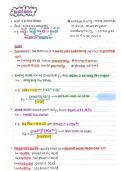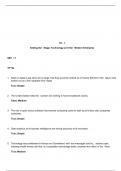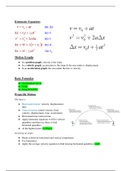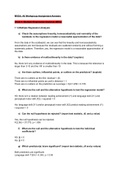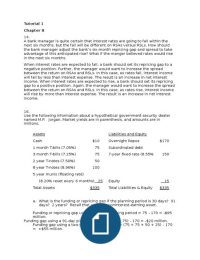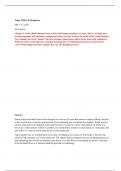LECTURE ONE
lecturer one
'
introduction to linear algebra
-
complex numbers
Quadratic equations
'
general formula →
ax + be + C =
0
( real
coefficients a. b. C ,
a # o )
by
'
at
x + sc + = 0
'
( %) ( Ea)
'
✗ + -
+
£ =o
( Ea)
'
e-
E)
+ 2
⇐
= -
a
'
B2-4AC
µ tea )
+ =
Za
B2-4AC
tea
x + =
Za
0C = -
b In B2-4AC
2A
assuming discriminant
B2-4AC is non
negative
-
complex numbers
'
=L = -1 introduces an
imaginary unit ,
and set
it = -
I i = A
complex numbers are written in the Cartesian form
and real
✗ +
iy where
2
sc
y are numbers and
i = -
I
oc =
Re 1-2)
1m It )
y
=
both are real numbers .
all real numbers a c- IR are uicluded in the set € of all
complex numbers saying a = a + io
, and real
iy
the number 2- × + where × are
y
=
,
can be represented as a point on the co -
ordinate plane .
atm
subtracting
2- = x +
iy
y
- -
→
- -
is also like the subtraction of
;
planar vectors .
→
so the
Z,
Zz
-
=/ x
,
+
iy ) ,
-
(x >
+
iy ) ,
Addition
ly yz )
= (x ,
-
✗
a) + i
,
-
is like addition of planar
^
1M
vectors .
I oc
, y ) + ( x2 , y
) =
( x
,
+ ✗
z , y tyz )
, , , ,
Z2
1SC ,
+
iy ) ,
+ ( sci +
iyz )
=
(x ,
+ x2 ) t i
ly ,
+
yz )
^
2-
-22
-
,
geometrically we use i
£
parallelogram
,
the rule s
nlm Re
-9
Z
, +2-2
multiplication
-
try
-
2- , = 0C , , - l
'
s
starts with the bracket
>
"
expansion
2-2=34 tiyz
s
Re Z
,
Z
,
=
( ×
,
tiy ) ( ,
x
,
+
iyz )
= I
,x , t ×
, iy ,
t ✗
ziy ,
t
ity , Yz
( i ? 1) -
regroup .
the expressions in the brackets are =
4C , sci
-
y , y , ) + i /× ,
y ,
+
Kay ) ,
real numbers hence the result is a
,
→
complex number
main properties of the three operations
commlltativity -2 t
2-2 Zz 2- -2
2-2 2-2-2
=
-
t =
, I , ,
It
"
2)
"
associativity =L
(2-2+2-3) + 2- + Z
-
+ =
, , }
distribute vity -
Z
,
I Zz t 2- 3) = Z
, Zz t Z ,
Z}
, LECTURE TWO
lecture three
complex conjugations nim
2- = ✗ +
iy
let 2- = x +
iy . its complex conjugate y
- - - -
-
-
-•
,
defined I
is as
iy
=
x -
t
od
'
Re
the operation 2- → É is complex conjugation .
I
its !
geometrically ,
the reflection of the complex -
y
- - - - -
- - -
in real axis
I = x
-
iy
plane the
properties
a- É =
-2 →
the double conjugation is the identity transformation
* if É =
2- then Z is real .
* the product É -2 = (x -
iy ) ( xtiy ) = ✗
'
+
y
'
is
always real and
non
negative
-
.
Division
mm
±
how to define
22
while keeping all standard properties of the
division ?
In particular ,
we want to be able to write the result in the form
a + ib
,
a
,
b t IR which would confirm that the result is a complex
number .
2-
,
Z
,
✗ Éz -2
,
= ×
,
+
iy , Zz
=
SC2 +
iyz
-
=
-22 2-2 ✗ Éz
= 2-
,
✗ Éz
xi +
y;
?
'
É
2-2=1×2 iya ) / xztiyz ) ; liyz ) i' ? ?
y;
-
=
x =
oc =
x +
y
- -
,
is real and positive if 2-2 =/ 0
modulus and
argument
the
writing 2- =
set
iy is the Cartesian form of the complex number 2- .
The modulus ( or absolute value ) of a complex number
2- = × +
iy is 12-1 =
,
✗
2
+
y
'
,* we denote the modulus also by r= 12-1 ( radius )
* this is the distance from the origin to the point 2- =
octiy
* remember É 2- =
✗
2
+
yz = 12-12
*
Always remember that 12-1 is real and positive ( unless 2- =o )
a 1M
2- =
octiy
y →
-
- - - -
# I
=\
g 1
! >
a Re
the
argument arglz ) of a complex number 2- = ✗ +
iy is the
angle between the positive real semi -
axis and the direction
from the origin to the point Z .
the
argument 0 is defined up to an integer number of
rotations
full about the origin .
Any integer multiple of 21T
may
be added to 0 to produce another admissible value of the
/ argument multi valued )
argument . The is
The
argument is measured in radians .
A 1M
y
- - -
- - -
→
2- = ✗ +
iy notice the
arglz ) when 2- =o is not
I defined .
'
't
=\ ,
✗
I in
general if oc =/ 0 then tano =¥
,
a) =
angle) I
,
×
The
However ,
a- tan
"
(1) is not
always true .
indeed the range of the function tan
"
is the interval ( I
-
,
E)
1¥ )
'
F- tan valid and 4th quadrants
-
therefore is for the 1st
only ,
that is , for so > 0 .
for the 2nd and 3rd quadrants ( the left half -
plane that is ✗ < 0 )
1¥ )
"
the simplest is to take D= tan + IT .
, LECTURE THREE
lecture three
The
projections of the position rector of the complex number E-
xtiy are :
✗ = r cos it
y=rsino
so we can write 2- = rcosotirsuno-lztlcosotisi.no)
this is called the
trigonometric form or polar form of a complex number .
^
'M
→
2-
=x+iy
I
r
y=rsino
,
'
✗ Re
=rcoso
The trigonometric form of a complex number is expressed in terms of its modulus
and
argument .
2- = 12-1 ( cos at isino )
The Cartesian form 2- =
✗ +
iy is better for addition or subtraction whereas
trigonometric ( or exponential) form is better for multiplication or division . .
further properties
* -2+7 = É + Ñ
* In = E I
* Z1J =
E1J
* I 2- I =
IE1
*
/ zf =
ZÉ
a- / ZW1 = I2-1IW /
a- I2-1WI =/ 2- I / IW1
complex numbers on the unit circle
The unit circle on the complex plane is the circle of radius 1 with its
centre at the origin .
Therefore numbers on it are those of modulus 1 : t = 12-1=1
so 2- = cosotis.no
Let us
multiply two numbers such Z and W with arguments 0 and ✗ .
ZW =/ Cos it + isino )( cos ✗ + isinx )
Costco > icososinxticosxsindtiisinos.int arglzw )
=
× + Thus
=
( Costco > x
-
Sino Sino ) tilcososinxtcosxs.int ) =
arglz) +
arg ( w
)
=
cos lots ) + i sin to + x )
lecturer one
'
introduction to linear algebra
-
complex numbers
Quadratic equations
'
general formula →
ax + be + C =
0
( real
coefficients a. b. C ,
a # o )
by
'
at
x + sc + = 0
'
( %) ( Ea)
'
✗ + -
+
£ =o
( Ea)
'
e-
E)
+ 2
⇐
= -
a
'
B2-4AC
µ tea )
+ =
Za
B2-4AC
tea
x + =
Za
0C = -
b In B2-4AC
2A
assuming discriminant
B2-4AC is non
negative
-
complex numbers
'
=L = -1 introduces an
imaginary unit ,
and set
it = -
I i = A
complex numbers are written in the Cartesian form
and real
✗ +
iy where
2
sc
y are numbers and
i = -
I
oc =
Re 1-2)
1m It )
y
=
both are real numbers .
all real numbers a c- IR are uicluded in the set € of all
complex numbers saying a = a + io
, and real
iy
the number 2- × + where × are
y
=
,
can be represented as a point on the co -
ordinate plane .
atm
subtracting
2- = x +
iy
y
- -
→
- -
is also like the subtraction of
;
planar vectors .
→
so the
Z,
Zz
-
=/ x
,
+
iy ) ,
-
(x >
+
iy ) ,
Addition
ly yz )
= (x ,
-
✗
a) + i
,
-
is like addition of planar
^
1M
vectors .
I oc
, y ) + ( x2 , y
) =
( x
,
+ ✗
z , y tyz )
, , , ,
Z2
1SC ,
+
iy ) ,
+ ( sci +
iyz )
=
(x ,
+ x2 ) t i
ly ,
+
yz )
^
2-
-22
-
,
geometrically we use i
£
parallelogram
,
the rule s
nlm Re
-9
Z
, +2-2
multiplication
-
try
-
2- , = 0C , , - l
'
s
starts with the bracket
>
"
expansion
2-2=34 tiyz
s
Re Z
,
Z
,
=
( ×
,
tiy ) ( ,
x
,
+
iyz )
= I
,x , t ×
, iy ,
t ✗
ziy ,
t
ity , Yz
( i ? 1) -
regroup .
the expressions in the brackets are =
4C , sci
-
y , y , ) + i /× ,
y ,
+
Kay ) ,
real numbers hence the result is a
,
→
complex number
main properties of the three operations
commlltativity -2 t
2-2 Zz 2- -2
2-2 2-2-2
=
-
t =
, I , ,
It
"
2)
"
associativity =L
(2-2+2-3) + 2- + Z
-
+ =
, , }
distribute vity -
Z
,
I Zz t 2- 3) = Z
, Zz t Z ,
Z}
, LECTURE TWO
lecture three
complex conjugations nim
2- = ✗ +
iy
let 2- = x +
iy . its complex conjugate y
- - - -
-
-
-•
,
defined I
is as
iy
=
x -
t
od
'
Re
the operation 2- → É is complex conjugation .
I
its !
geometrically ,
the reflection of the complex -
y
- - - - -
- - -
in real axis
I = x
-
iy
plane the
properties
a- É =
-2 →
the double conjugation is the identity transformation
* if É =
2- then Z is real .
* the product É -2 = (x -
iy ) ( xtiy ) = ✗
'
+
y
'
is
always real and
non
negative
-
.
Division
mm
±
how to define
22
while keeping all standard properties of the
division ?
In particular ,
we want to be able to write the result in the form
a + ib
,
a
,
b t IR which would confirm that the result is a complex
number .
2-
,
Z
,
✗ Éz -2
,
= ×
,
+
iy , Zz
=
SC2 +
iyz
-
=
-22 2-2 ✗ Éz
= 2-
,
✗ Éz
xi +
y;
?
'
É
2-2=1×2 iya ) / xztiyz ) ; liyz ) i' ? ?
y;
-
=
x =
oc =
x +
y
- -
,
is real and positive if 2-2 =/ 0
modulus and
argument
the
writing 2- =
set
iy is the Cartesian form of the complex number 2- .
The modulus ( or absolute value ) of a complex number
2- = × +
iy is 12-1 =
,
✗
2
+
y
'
,* we denote the modulus also by r= 12-1 ( radius )
* this is the distance from the origin to the point 2- =
octiy
* remember É 2- =
✗
2
+
yz = 12-12
*
Always remember that 12-1 is real and positive ( unless 2- =o )
a 1M
2- =
octiy
y →
-
- - - -
# I
=\
g 1
! >
a Re
the
argument arglz ) of a complex number 2- = ✗ +
iy is the
angle between the positive real semi -
axis and the direction
from the origin to the point Z .
the
argument 0 is defined up to an integer number of
rotations
full about the origin .
Any integer multiple of 21T
may
be added to 0 to produce another admissible value of the
/ argument multi valued )
argument . The is
The
argument is measured in radians .
A 1M
y
- - -
- - -
→
2- = ✗ +
iy notice the
arglz ) when 2- =o is not
I defined .
'
't
=\ ,
✗
I in
general if oc =/ 0 then tano =¥
,
a) =
angle) I
,
×
The
However ,
a- tan
"
(1) is not
always true .
indeed the range of the function tan
"
is the interval ( I
-
,
E)
1¥ )
'
F- tan valid and 4th quadrants
-
therefore is for the 1st
only ,
that is , for so > 0 .
for the 2nd and 3rd quadrants ( the left half -
plane that is ✗ < 0 )
1¥ )
"
the simplest is to take D= tan + IT .
, LECTURE THREE
lecture three
The
projections of the position rector of the complex number E-
xtiy are :
✗ = r cos it
y=rsino
so we can write 2- = rcosotirsuno-lztlcosotisi.no)
this is called the
trigonometric form or polar form of a complex number .
^
'M
→
2-
=x+iy
I
r
y=rsino
,
'
✗ Re
=rcoso
The trigonometric form of a complex number is expressed in terms of its modulus
and
argument .
2- = 12-1 ( cos at isino )
The Cartesian form 2- =
✗ +
iy is better for addition or subtraction whereas
trigonometric ( or exponential) form is better for multiplication or division . .
further properties
* -2+7 = É + Ñ
* In = E I
* Z1J =
E1J
* I 2- I =
IE1
*
/ zf =
ZÉ
a- / ZW1 = I2-1IW /
a- I2-1WI =/ 2- I / IW1
complex numbers on the unit circle
The unit circle on the complex plane is the circle of radius 1 with its
centre at the origin .
Therefore numbers on it are those of modulus 1 : t = 12-1=1
so 2- = cosotis.no
Let us
multiply two numbers such Z and W with arguments 0 and ✗ .
ZW =/ Cos it + isino )( cos ✗ + isinx )
Costco > icososinxticosxsindtiisinos.int arglzw )
=
× + Thus
=
( Costco > x
-
Sino Sino ) tilcososinxtcosxs.int ) =
arglz) +
arg ( w
)
=
cos lots ) + i sin to + x )

